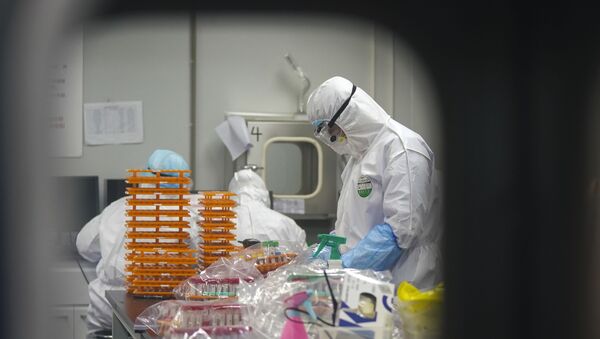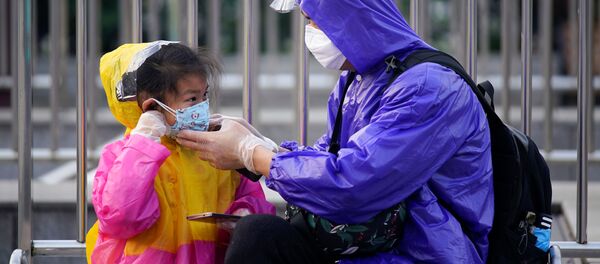A British media investigation claims a team of Chinese scientists spotted a "strain" that is closest to the novel coronavirus in a deserted, bat and rat infested mine in 2013 and have since stored it at a landmark virology lab in Wuhan.
According to a report by The Sunday Times, citing a Chinese publication in the journal Nature, the discovery of the corona sister virus in the copper mine in southwest China could be the strongest lead to date to finding out where the currently raging pandemic actually started. Multiple western media outlets, including British tabloids, immediately picked up on the claims, suggesting the Chinese researchers could have intentionally kept the world in the dark about the novel contagious virus.
The Times traced several deaths attributed to the then-spotted infection: in 2012, six men were reportedly struck down with a fever, and pneumonia, half of them fatally, after working in the mineshaft clearing bat faeces.
Four of the men tested positive for antibodies to some unknown SARS-like virus, as per the report, but two had already died by the time the tests were carried out. At the time, the cause of their deaths was linked to fungus found in the mine cavity.
In a paper called "Coexistence of multiple coronaviruses in several bat colonies in an abandoned mineshaft" published in 2016, Dr Shi Zhengli, nicknamed "Bat Woman" by her colleagues, wrote that of the 152 genetic sequences of coronavirus found in the mine, two were similar to that which had caused SARS. One was reportedly described as a "new strain" of SARS and called RaBtCoV/4991, before later being renamed RaTG13, with the fact spawning multiple conspiracy theories.
In addition to setting out a full genetic description of the virus, Dr Shi’s paper, published in Nature several years after the finding, revealed that the WIV housed a sample of virus extracted from bats named RaTG13, which it said was a 96.2 percent match with the COVID-19 virus. It was incidentally also Shi who this February co-authored the most extensive academic paper on the novel coronavirus to date.
The Times quoted scientists as saying it should not be ruled out that the two viruses may once have been the same. For instance, the type of techniques required to turn RaTG13 into SARS-Cov-2 are "identical" to work previously carried out in Wuhan, which houses the biggest institute of biology in the world, alleges Professor Richard Ebright of Rutgers University’s Waksman Institute of Microbiology in New Jersey.
"The very same techniques, the very same experimental strategies using RaTG13 as the starting point, would yield a virus essentially identical to SARS-Cov-2", he told The Sunday Times.
Most scientists, however, dwell on SARS-Cov-2's genetic code, suggesting it has mutated naturally and has not been specially crafted or engineered, like President Donald Trump previously hinted at.
Professor Martin Hibberd of the London School of Hygiene & Tropical Medicine asserted that to do so would be "exceptionally difficult", sharing with the paper that they "are not the same virus and I don’t think you can easily manipulate one into the other".
When the British newspaper reported about the 7-year-old sample, the closest relative to the novel coronavirus, having been allegedly shelved, researchers suggest it could hardly have been done on purpose in light of several human deaths.
"The conspiracy folks are saying there’s something suspicious about the change in name, but the world has changed in six years – the coding system has changed".
Peter Daszak, president of EcoHealth Alliance, who collaborated with Dr Shi, said stressing that "if you really thought you had a novel virus that had caused an outbreak that killed humans then there is nothing you wouldn’t do" to get to the very bottom of that.
Tug of War Over Pandemic Origins
The investigation came amid a fierce spat between the US and China over the origins of the COVID-19 pandemic, with the US president accusing China of "concealing" the outbreak and mismanaging its containment, as well as claiming the pandemic was the result of a leak at the Wuhan Institute of Virology. The director of the WIV, Wang Yanyi, gave an interview in May in which she blasted the suggestions that the COVID-19-triggering virus might have leaked from the lab as “pure fabrication”. Chinese officials have forcefully denounced the US' claims, arguing their handling of the pandemic was absolutely transparent and they reported their flare-ups and started to take measures as soon as the issue arose.
The conflict between the US and China over the pandemic even turned into threats from Washington to use tariffs against Beijing over China's "mishandling of the coronavirus crisis". The Chinese side warned against politicising the healthcare matter, arguing a new trade conflict, which is already there due to the Huawei row, would hurt all the parties involved.
The pandemic has been yet another line of confrontation between China and the western world led by the US, with the row over the origins of the COVID outbreaks coming on the heels of the Huawei spat over alleged "backdoors" in the Chinese telecom technologies, and trade issues between Washington and Beijing, which have seen the two exchange several rounds of tariffs.





